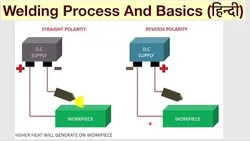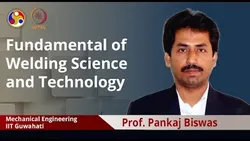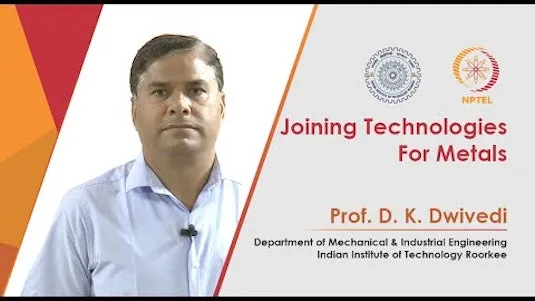
Welding And Its Types 
This course provides an overview of welding and its types. It covers the basics of gas welding, submerged arc welding, thermit welding, spot and seam welding, carbon electrode welding, and metal inert gas welding. It explains the welding process and basics in an easy to understand way. It also provides an introduction to the different types of welding and their applications. ▼
ADVERTISEMENT
Course Feature
![]() Cost:
Cost:
Free
![]() Provider:
Provider:
Youtube
![]() Certificate:
Certificate:
Paid Certification
![]() Language:
Language:
English
![]() Start Date:
Start Date:
On-Demand
Course Overview
❗The content presented here is sourced directly from Youtube platform. For comprehensive course details, including enrollment information, simply click on the 'Go to class' link on our website.
Updated in [May 25th, 2023]
This course provides an overview of welding and its various types. It covers the basics of welding processes and how to understand them easily. It also explains gas welding basics, submerged arc welding, thermit welding, spot and seam welding, electrode arc welding with a non-consumable electrode, and metal inert gas (MIG) welding. Participants will gain an understanding of the different types of welding and how to use them.
[Applications]
The application of this course can be seen in many industries. It can be used to join two pieces of metal together, to repair broken parts, and to fabricate new components. It can also be used to create custom pieces for a variety of projects. With the knowledge gained from this course, welders can confidently and safely perform welding tasks in a variety of settings. Additionally, welders can use the information to troubleshoot welding problems and to make informed decisions about the best welding process for a particular job.
[Career Paths]
1. Welding Engineer: Welding engineers are responsible for designing, developing, and overseeing the welding process for a variety of projects. They must have a strong understanding of welding techniques and materials, as well as the ability to troubleshoot and solve problems. With the increasing demand for new and innovative welding techniques, welding engineers are in high demand and the job outlook is expected to remain strong.
2. Welding Technician: Welding technicians are responsible for the day-to-day operations of welding projects. They must have a strong understanding of welding techniques and materials, as well as the ability to troubleshoot and solve problems. With the increasing demand for new and innovative welding techniques, welding technicians are in high demand and the job outlook is expected to remain strong.
3. Welding Inspector: Welding inspectors are responsible for ensuring that welding projects meet safety and quality standards. They must have a strong understanding of welding techniques and materials, as well as the ability to troubleshoot and solve problems. With the increasing demand for new and innovative welding techniques, welding inspectors are in high demand and the job outlook is expected to remain strong.
4. Welding Fabricator: Welding fabricators are responsible for fabricating and assembling metal components for a variety of projects. They must have a strong understanding of welding techniques and materials, as well as the ability to troubleshoot and solve problems. With the increasing demand for new and innovative welding techniques, welding fabricators are in high demand and the job outlook is expected to remain strong.
[Education Paths]
1. Bachelor of Science in Welding Engineering: This degree program focuses on the science and technology of welding, including the principles of metallurgy, welding processes, welding design, welding safety, and welding inspection. It also covers the fundamentals of welding engineering, such as welding metallurgy, welding processes, welding design, welding safety, and welding inspection. This degree program is ideal for those who want to pursue a career in welding engineering, as it provides the necessary knowledge and skills to become a welding engineer. Developing trends in this field include the use of advanced welding techniques, such as laser welding, and the use of robotics in welding.
2. Associate of Applied Science in Welding Technology: This degree program focuses on the practical application of welding technology, including welding processes, welding safety, and welding inspection. It also covers the fundamentals of welding technology, such as welding metallurgy, welding processes, welding design, welding safety, and welding inspection. This degree program is ideal for those who want to pursue a career in welding technology, as it provides the necessary knowledge and skills to become a welding technician. Developing trends in this field include the use of advanced welding techniques, such as laser welding, and the use of robotics in welding.
3. Certificate in Welding Technology: This certificate program focuses on the practical application of welding technology, including welding processes, welding safety, and welding inspection. It also covers the fundamentals of welding technology, such as welding metallurgy, welding processes, welding design, welding safety, and welding inspection. This certificate program is ideal for those who want to pursue a career in welding technology, as it provides the necessary knowledge and skills to become a welding technician. Developing trends in this field include the use of advanced welding techniques, such as laser welding, and the use of robotics in welding.
4. Master of Science in Welding Engineering: This degree program focuses on the advanced principles of welding engineering, including welding metallurgy, welding processes, welding design, welding safety, and welding inspection. It also covers the fundamentals of welding engineering, such as welding metallurgy, welding processes, welding design, welding safety, and welding inspection. This degree program is ideal for those who want to pursue a career in welding engineering, as it provides the necessary knowledge and skills to become a welding engineer. Developing trends in this field include the use of advanced welding techniques, such as laser welding, and the use of robotics in welding.
Course Provider

Provider Youtube's Stats at AZClass
Discussion and Reviews
0.0 (Based on 0 reviews)
Explore Similar Online Courses

Monochrome paintings with Watercolor - Learn to paint using a single color

JavaScript for beginners: build real world dynamic projects

Python for Informatics: Exploring Information

Social Network Analysis

Introduction to Systematic Review and Meta-Analysis

The Analytics Edge

DCO042 - Python For Informatics

Causal Diagrams: Draw Your Assumptions Before Your Conclusions

Whole genome sequencing of bacterial genomes - tools and applications

Welding Safety

Fundamental of Welding Science and Technology


Start your review of Welding And Its Types